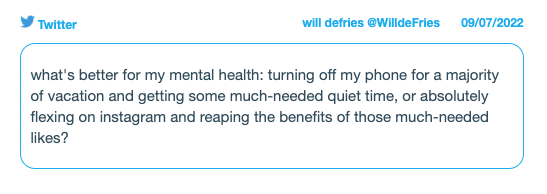
I Am a Camera
August 28, 2022
Pantheon of Communication Greats
October 10, 2022
September 15th, 2022

By: Michael Chad Hoeppner
Published: Sept. 15th, 2022
Most editions of Good Talk will focus on topical communication themes; this one does so, but via a personal cell phone mishap I experienced this summer.
My phone was stolen while I was traveling. After the expected panic about securing personal information, my concerns shifted to two thoughts: the first I would have anticipated, the second I wouldn’t have. Instant thought #1 (expected): “Oh, no! What if I lose all my photos if they’re not in the cloud!” Instant thought #2 (unexpected): “Does it matter anyway? Will I ever go back and look at all the photos in the years and years of photos I have?”
Like everything else they touch in our modern lives, phones have changed our relationship to photos. And though I spend most of my time focused on helping people communicate more effectively with words, my phone pickpocket experience made me reflect on how we communicate with images. If a picture is worth a thousand words, how many words are they worth if no one ever looks at them?
I found myself musing on what happens with all the photos we take. How many average photos do people have in their phone’s libraries? What percentage of those photos do they ever look at again? What percentage of the total photos in their libraries are a series of 6 or 10 or 25 essentially identical images that were taken “for safety” to ensure at least one is good? Will all those extra facsimiles ever get tidied and deleted? If the pictures are selfies for posting on social media, who are the online friends and family who will ever actually see them, and what will they think when they do? If you’ve spent any time on any beach on any continent this summer, you will undoubtedly have witnessed people taking photos alone, turning the beach into an outdoor photo studio; how many additional minutes of vacation does it take to get a flawless Instagram-worthy selfie?
The causes and connections of our transformed relationships to images by the phone camera are many: social media; digital photos that are free and instant; the ubiquity of phones; and more.
So how can we be intentional when using these devices that have transformed every aspect of our lives, specifically how we take and digest images? Like many things we teach at GK Training, we like to offer our clients highly behavioral suggestions, whenever possible physicalizing the behaviors to help unlock embodied cognition.
Communication is about reaching the other person. So as a tiny, fun way to force an intervention into your life and remind you that photographs too have a “speaker” and “audience,” the next time you’re taking a selfie or having someone do it for you, try this tiny physical and vocal exercise. Point at the phone with your finger and say out loud: 1) the name of the person you hope sees the photo you’re about to take; and 2) a thought you would like them to hear. Notice if too many times what comes out of your mouth has a degree of one-upmanship or even schadenfreude. If so, note the free real estate those feelings are getting in your head and heart. It might be better to put down your phone and pick up that beach-read book!
If what comes out of your mouth are warm and fuzzy feelings about your friends and family, consider doing the following shocking thing. Don’t just send them the image in a text message (which will likely just gum up memory in their text app, or room in their photo library if they import the image) – call that person. Don’t leave a voicemail; they won’t listen anyway. But they will have seen they missed a call from you, and maybe that call will interrupt their beach photo session!
WHAT WE’RE READING:
Retro technology and older gadgets have staying power in part because they allow people to unplug from the constant ping-ping-ping of their devices. Interest among Gen Z and Millennials in film cameras has picked up in recent years.
“Understanding the intention behind a photo is absolutely critical to creating an image that will last forever and have significance to you,” says Zalcman. That may be as simple as saying to yourself: “OK, I’m going to take a photo of my niece acting like the general contractor of this sandcastle, because it makes me laugh,” or “I’m going to take a picture of this painting at the museum because I like the colors.”
Journalists have been documenting this phenomenon, addressing the deleterious mental health effects of seeing yourself as others see you and offering ways to cope with the new self-knowledge. Many articles treat the issue as a kind of trauma, another example of the bodily insecurity the internet provokes, which some call “filter dysmorphia.” Related: Instagram, Snapchat, TikTok Cause Mental Health Problems in Teens, Lawsuits Claim – The Hollywood Reporter
An in-person conversation or even a phone call would be best, he says: “I don’t think asking for these things over text is going to be the most effective.” Even if you feel awkward or nervous about it, remember that they will likely be more appreciative that you called than you think.
Roughly half of workers overthink the communications they send and 62% say worrying about miscommunication at work affects their overall mental health. […] “Reading carefully is the new listening. Writing clearly is the new empathy. And a phone or video call is worth a thousand emails,” writes Erica Dhawan, author of “Digital Body Language.” “Empower your teams to be intentional with their communication. Streamline meetings with agendas and have clear objectives,” advises Zeb Evans, CEO and founder of ClickUp.
WHAT INFLUENCERS ARE SAYING:









